Help us LEAP forward with PTAB assistance for practitioners and inventors
Blog by Kathi Vidal, Under Secretary of Commerce for Intellectual Property and Director of the USPTO
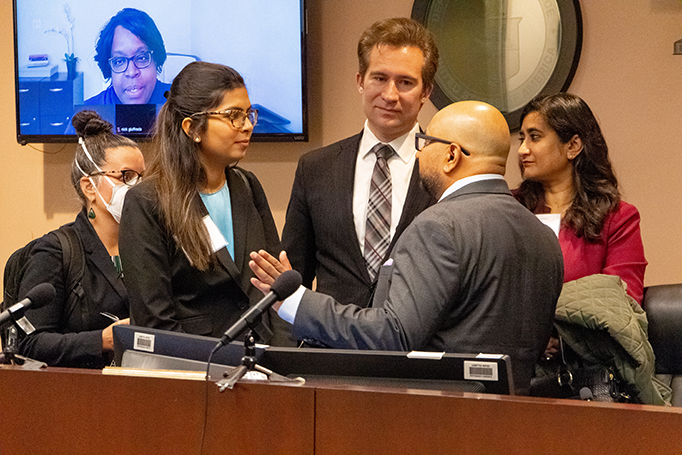
Since the moment I was sworn in as Director of this great agency two years ago, I have been guided by the conviction that we must open the doors of opportunity in the innovation community to everyone, not just a select few. Only when every inventor and entrepreneur has an equal chance to bring their new ideas and products to the global marketplace, on a level playing field, does our nation truly thrive.
There are many things we have done at the USPTO to push those doors of opportunity wide open, but I want to highlight a few in particular that I need your help in sharing with others. Collectively, they make access to the Patent Trial and Appeal Board (PTAB) easier and more transparent than ever, for both legal practitioners and the inventors they represent.
First, we are eager to engage with the public on our proposed rule to amend the criteria individuals must meet to practice before the PTAB. This rule will expand opportunities for more individuals to participate in our innovation ecosystem, while not compromising our goal of issuing and maintaining robust and reliable intellectual property rights. We encourage stakeholders to submit comments by May 21.
The next two programs are part of our continuing efforts, through the Legal Experience and Advancement Program (LEAP), to empower the next generation of advocates and prepare them for meaningful, impactful work early in their careers.
“LEAP to Chambers” brings eligible practitioners to a USPTO hearing facility, where a PTAB judge will give them a behind-the-scenes tour. They will get a feel for the hearing room by standing behind the podium and testing out their openings. They will learn how to display evidence at a hearing, and they may sit at the bench and view the hearing room and evidence from the judges’ vantage point. A remote judge also will join the tour to provide tips on how to most effectively argue before a hybrid panel of in-person and remote judges.
After the tour, judges spend time with practitioners highlighting effective advocacy techniques and answering questions. These conversations are a safe space for practitioners outside the context of a real argument or ongoing proceeding to seek clarification on PTAB procedures.
In “LEAP to Law Schools,” judges visit law schools and offer an overview of PTAB proceedings, including demonstration of a mock argument. By exposing law school students to PTAB so early in their legal careers, the USPTO encourages greater and more inclusive participation by law students in the intellectual property field and better equips them to practice before the USPTO.
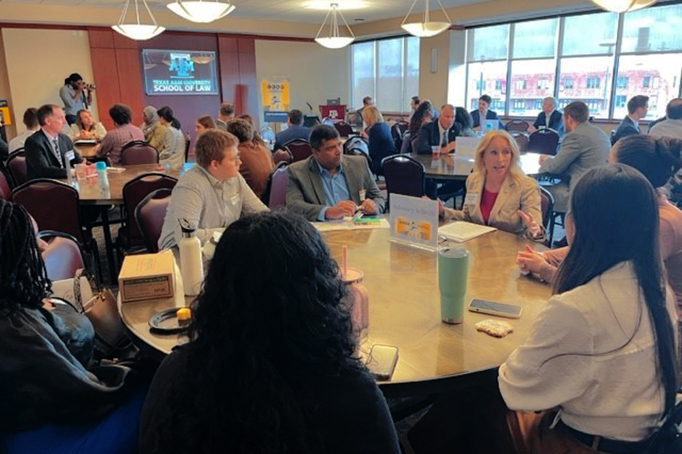
In addition to these two new programs, PTAB continues to offer LEAP-eligible practitioners the opportunity to present mock oral arguments and practice their advocacy skills before a panel of judges and receive individualized feedback.
Since LEAP launched more than three years ago, over 350 eligible practitioners and 135 law firms have participated. But we are still just getting started, and we need your help. Whether you are in-house or work for a large law firm, or anything in between, please share these free training opportunities widely within your professional networks, and encourage the next generation of practitioners to take full advantage of them.
We also recently launched a new PTAB Moot Court Competition for law students to develop and practice the written and oral advocacy skills needed for America Invents Act (AIA) proceedings. This free, fully virtual program is open to teams of students who will be enrolled in law school full-time or part-time during the 2024-2025 academic year. Students will get to work closely with an Administrative Patent Judge (APJ) coach, receive practical tips and experience on how to best present a case before the PTAB, and participate in live oral arguments before a panel of APJs. We encourage law school faculty members or administrators to visit the program webpage for more information and submit an interest form by March 31.
Another opportunity we need your help in promoting is the PTAB Pro Bono Program , which serves under-resourced inventors seeking to appeal a patentability rejection by an examiner. We launched the program in 2022 in collaboration with the PTAB Bar Association, and since then, a number of licensed patent attorneys, registered to practice before the USPTO, have offered their free services to represent independent inventors, inventor groups, and inventor-owned small businesses in ex parte appeals. Where we need your help most is in promoting the program more widely within the inventor community.
To be eligible for PTAB pro bono assistance, an individual inventor must:
• Reside in the United States;
• Have a total household income of less than 400% of the federal poverty guidelines;
• Successfully complete a training course consisting of two videos, one on how PTAB Pro Bono operates and how to apply for assistance, and the other on the ex parte appeal process;
• Apply to the program within one month from the date of an office action in which the claims have been twice or finally rejected; and
• Not be under an obligation to assign (sell or give ownership of) the application or resulting patent to a third party.
Inventors who are part of an inventor group of up to four known inventors must meet the qualifications listed above. Inventor-owned small businesses are eligible if they are 100% inventor-owned and if each inventor-owner meets the qualifications listed above. If the business was operating in the calendar year prior to the application for pro bono assistance, it must have had a total gross income of less than $150,000, and the business must expect/project a total gross income of less than $150,000 in the calendar year when the application for pro bono assistance is filed.
Please visit the LEAP and PTAB Pro Bono pages of the USPTO website for more information, share them with others, and feel free to contact me at Director@uspto.gov if you can’t find your answers there. I look forward to discussing these programs and more at the PTAB Bar Association Annual Conference on March 7.
Together, we can make a difference for the next generation of patent practitioners, the inventors they represent, and our nation’s future!
Posted at 09:21AM Feb 29, 2024 in USPTO | Comments[0]
AI and inventorship guidance: Incentivizing human ingenuity and investment in AI-assisted inventions
Blog by Kathi Vidal, Under Secretary of Commerce for Intellectual Property and Director of the USPTO

Posted at 04:42PM Feb 12, 2024 in USPTO | Comments[3]
Support for protecting and enforcing your IP in China
Blog by Kathi Vidal, Under Secretary of Commerce for Intellectual Property and Director of the USPTO
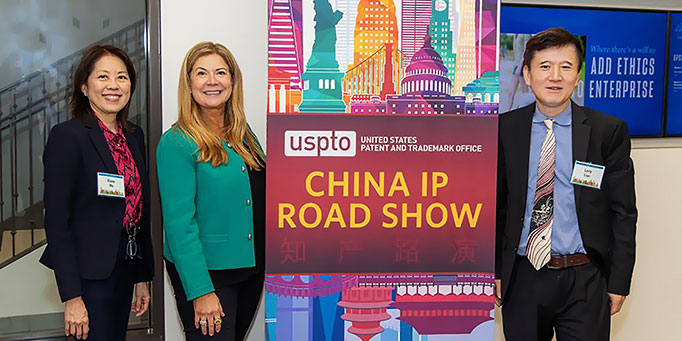
Since the start of my tenure as Director in spring 2022, protecting and enforcing intellectual property (IP) rights in China has been an essential part of our agency efforts to strengthen the global IP system. U.S. businesses operating in China regularly cite insufficient protection and enforcement of IP as a top concern, and the Office of the U.S. Trade Representative has placed China on its “priority watch” list for over a decade, detailing a long list of IP concerns reported by U.S. businesses operating in China.
I am committed to promoting a level playing field for U.S. rights holders in China and providing insight on the unique challenges they face. We are fortunate to have a USPTO team of attorneys and IP experts focused on China. The China team includes over a dozen stateside IP attorneys and three IP attachés and legal staff in Beijing, Shanghai, and Guangzhou, China. These experts engage with other federal agencies, U.S. stakeholders, and their Chinese government counterparts to advocate for U.S. rights holders doing business in and exporting to China.
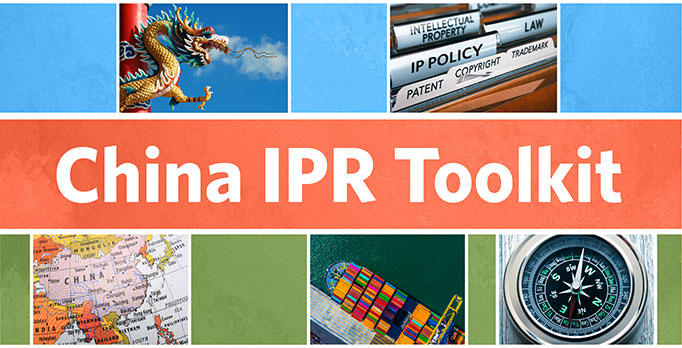
It can be difficult to do business in China. The China IPR Toolkit can serve as a helpful first stop on that journey. It is available as a free download from the USPTO website.
I’ve seen first-hand American businesses working to educate themselves on China IP. In October, I joined private sector and government experts in San Diego at the USPTO China IP Roadshow. These one-day, in-person events held around the country detail for local entrepreneurs and businesses how they can protect and enforce their IP in China. They are tailored to their specific locales, taking into account the leading local industries—biotech, manufacturing, agriculture, or the creative industries, to name a few. We bring in experts who can address the particular challenges faced by these businesses. We also offer the expertise and knowledge of the USPTO’s China IP specialists, local businesspeople, and IP experts.
Since 2017, we’ve held more than 30 China IP Road Show events in every corner of the country. To learn more about past and upcoming China IP Road Shows, visit the USPTO website.
In our work, I’m grateful for the leadership of U.S. Secretary of Commerce Gina Raimondo. Secretary Raimondo traveled to Beijing and Shanghai last year to meet with her Chinese government counterparts and representatives of leading U.S. businesses operating in China. She and China’s Minister of Commerce Wang Wentao agreed that U.S. and Chinese subject matter experts will hold technical discussions regarding strengthening the protection of trade secrets and confidential business information during administrative licensing proceedings in China. To facilitate that initiative, I have made the USPTO’s China IP experts available to support it and any other related IP initiatives that develop.
The China IPR Toolkit and the China IP Road Shows are just two of a number of initiatives spearheaded by our China team. I encourage you to visit the China IP page of our website to see the resources we offer, and sign up for future road shows and webinars.
Posted at 08:22AM Jan 18, 2024 in USPTO |
Working globally to address climate change through sustainable innovation
Blog by Kathi Vidal, Under Secretary of Commerce for Intellectual Property and Director of the USPTO
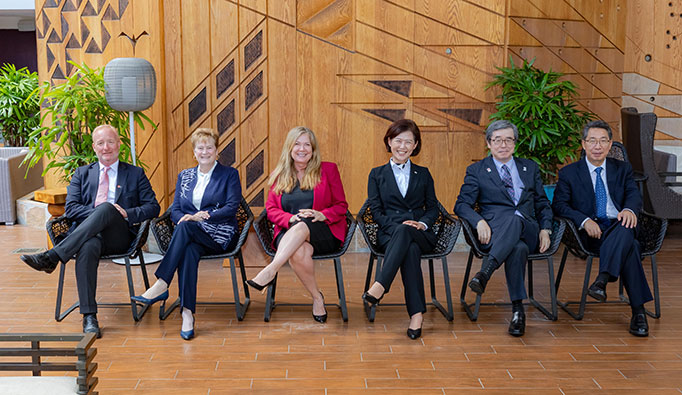
Recently, I had the privilege of hosting the leaders of the largest intellectual property (IP) offices in the world – the European Patent Office (EPO), the Japan Patent Office (JPO), the Korean Intellectual Property Office (KIPO), and the China National Intellectual Property Administration (CNIPA), along with the World Intellectual Property Organization (WIPO), for the annual meeting of the IP5, which took place in Hawai’i. I then led the USPTO delegation to the 64th Assemblies of the Member States of WIPO, an annual meeting with over 190 international IP offices from around the world in Geneva, Switzerland.
One topic of international concern to us all was how to work together to support sustainable innovation and as we look to solve global climate change. There is a pressing need for more innovation in the green tech space, and we need new technologies to mitigate the effects climate change. This is an international issue that affects all of us, and we discussed how we can work together to bring sustainable innovations to global impact.
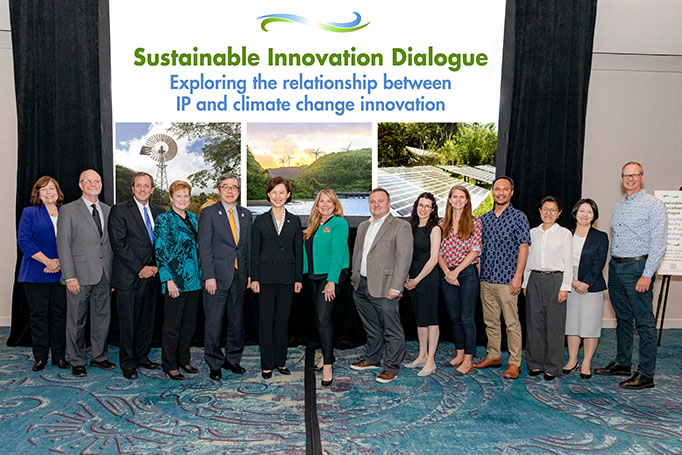
During our sustainable innovation dialogue at IP5, we discussed how we can work together towards a goal of net-zero carbon emissions to help mitigate climate change and preserve our environment. The IP5 leaders shared information on initiatives that encourage patent filings in climate technologies in their countries, streamline examination, and encourage eco-friendly efforts, such as paperless filing and energy efficiency. We brought together innovators, accelerators, and funders, as well as our sister agency, the National Oceanic and Atmospheric Administration (NOAA), to determine how we can be a catalyst to bring climate change technologies from research to the marketplace. Read more about the joint commitment to this important issue, and learn about current trends and programs across the IP5 countries in the Climate Initiatives Booklet.
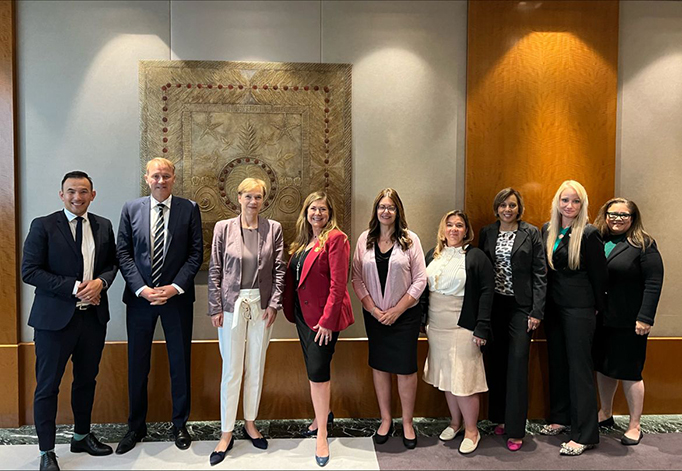
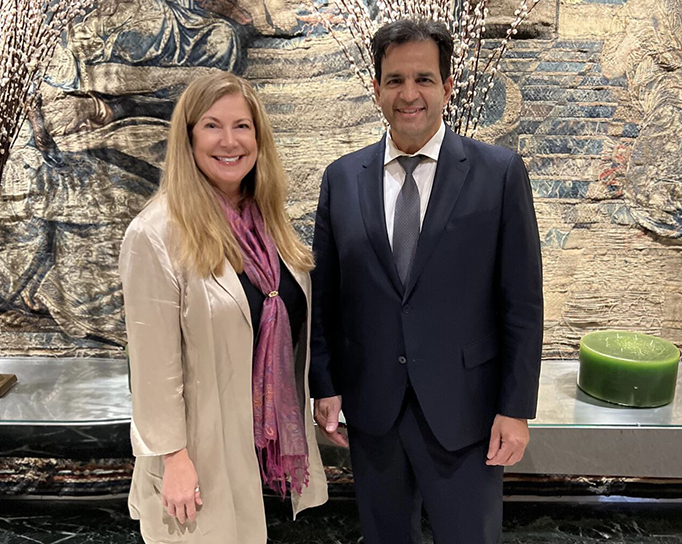
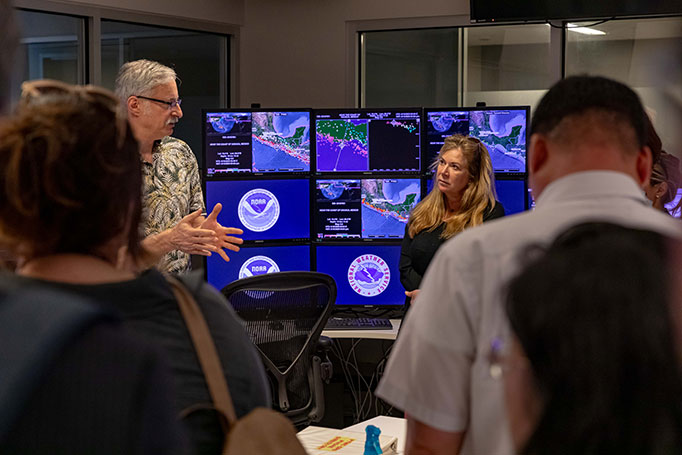
Posted at 03:29PM Aug 09, 2023 in USPTO | Comments[6]
Patenting innovation in climate science
Note: This blog originally published on the NOAA Research blog.
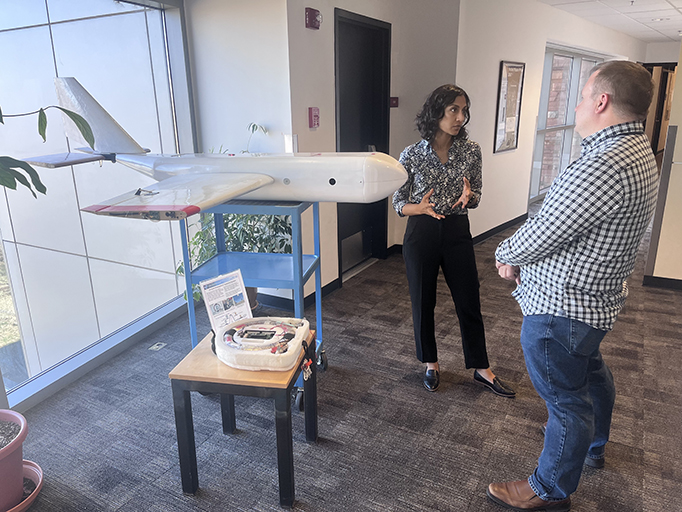
Parikha Mehta and Wayne Mackenzie discussing Dr. Bianca Baier’s innovative AirCore atmospheric sampling device and the HORUS glider at the NOAA Global Monitoring Laboratory in April 2023. Credit: NOAA
A Q&A with Parikha Mehta from the U.S. Patent and Trademark Office
Parikha Mehta has spent the last four months focused on the intersection of intellectual property and climate and environmental technologies while on an employee exchange (known as a detail) at NOAA from the U.S Patent and Trademark Office (USPTO). Her goal: Help researchers understand the importance of protecting their inventions so that NOAA’s research and technology can better serve the public and inspire future innovation.
The work overlaps with her usual job as a senior patent examination policy advisor at USPTO. “In my USPTO role, I focus on advising all types of stakeholders on our patent policy– soup to nuts of the whole patent process,” she says.
At NOAA, Mehta visited labs and fisheries science centers and interviewed researchers about their knowledge of the patent process and technology transfer.
We sat down to ask her about her experience, and intellectual property issues.
How did you hear about the employee exchange opportunity with NOAA? What motivated you to apply?
I heard about this opportunity through the USPTO detail announcement program; our agency is really supportive of career development through short-term reassignment opportunities. My background is in science and engineering, and I was excited for the chance to spend some time a little closer to that. I was also eager to share my knowledge of patent law and policy to hopefully help people who are trying to solve problems I care about personally. Before I started this detail, I knew broadly that NOAA was engaged in important research in a lot of different areas, but I didn’t appreciate the full scope of the agency’s impact until I got here. I’ve so enjoyed talking to the talented scientists and engineers here; meeting people and learning about their work has been incredibly rewarding, and also just a lot of fun.
Why is it important for researchers to patent inventions?
I’ve been inspired by how passionate NOAA researchers are about using science and engineering to help the public and the planet. Patents are a great vehicle for that, because they create a pathway for transforming innovation in the lab into something that the public can access and benefit from in day to day life.
Patents are also a tool for protecting the integrity of the important work that’s being done at NOAA. If somebody else tries to claim ownership of an idea, or use it in a way that doesn’t meet NOAA’s high standards, that can harm the agency and the public. Patents can provide insurance against those things. For example, I met several NOAA researchers who are working on innovative tools for collecting improved data from the ocean or the atmosphere. If those tools are patented, NOAA can confidently share them for broader public use knowing there is a measure of protection against anyone else distributing sub-standard knockoffs or erasing NOAA’s rightful credit for that innovation.
What is holding people back? Why do you think people don’t seek out a patent?
I think it’s mostly a matter of awareness. Scientists, engineers, and managers are often unfamiliar with how patents work, how they relate to federal research, and how to apply for them. The next two USPTO detailees will use what I’ve found to help NOAA’s research workforce learn about these topics, and hopefully help them feel more comfortable and confident when initiating discussions about how to protect NOAA inventions.
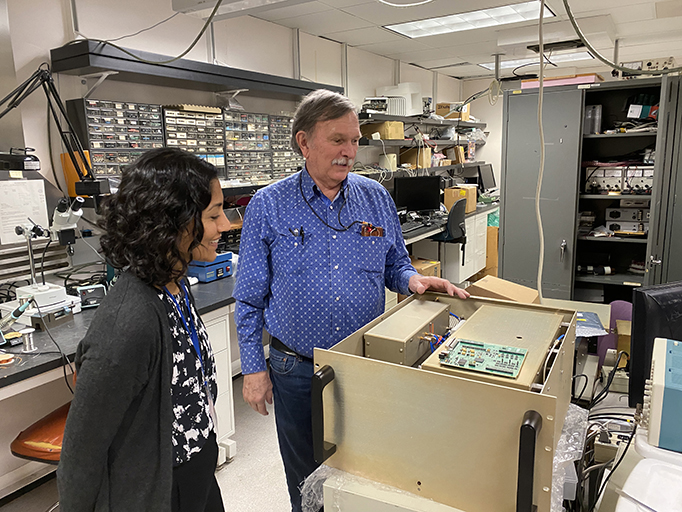
Dr. Paul Johnston showing Parikha an engineering work-in-progress in his lab at NOAA’s Physical Sciences Lab in April 2023. Credit: NOAA
What do you say to someone who is hesitant about patenting?
Researchers sometimes feel that their inventions aren’t suitable for filing a patent application because they are too niche, too specific to a particular problem they are trying to solve in their lab. They assume that nobody else is going to want or be able to use their invention,so they talk themselves out of trying to pursue a patent for it. To that, I would say don’t sell yourself short; no invention is too small. The NOAA Technology Partnerships Office has talented people who can guide that part of the decision making process; all you have to do is let them know you invented something, and they’ll help figure out the best path forward from there.
What has been the biggest surprise to you about NOAA and the culture here?
I don’t know if I would characterize this as surprising, but everyone’s strong mission identity and commitment to public service here has definitely made an impression on me. People show up to work here because they genuinely want to do good and help others; this really shone through in my interactions with every person I met at NOAA, not just the researchers. . It’s been wonderful, and probably one of the things I will remember most about this experience.
Mehta is the first of three USPTO employees assigned to NOAA this year. While Mehta’s been working at NOAA, another detailee has also gone from NOAA to USPTO to share climate science with their staff and advise on USPTO green initiatives. In a forthcoming article we will talk to that detailee about their experiences.
Posted at 07:39AM Jun 27, 2023 in USPTO | Comments[20]
Patent Pro Bono Program expands and reaches underserved populations with free legal services
Guest blog by Derrick Brent, Deputy Under Secretary of Commerce for Intellectual Property and Deputy Director of the United States Patent and Trademark Office
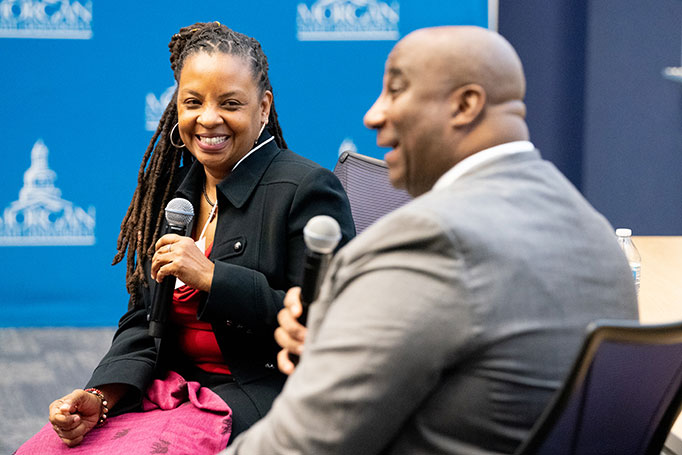
Over the past few months, I have been visiting cities across the country on a nationwide tour to share information about our Patent Pro Bono Program and other free and useful services for entrepreneurs. From Wake Forest University to Historically Black Colleges and Universities such as Morgan State, North Carolina A&T and Howard University, Director Vidal and I have been meeting and connecting with pro bono service providers, entrepreneurs, and students to discuss issues such as the value of intellectual property (IP) for small businesses, and bringing new entrepreneurs and inventors into the innovation ecosystem.
Entrepreneurs discussed how USPTO services like the Patent Pro Bono Program helped them grow their businesses and reach the marketplace. Volunteer legal counsel and clinic students expressed how meaningful it was to be part of the entrepreneurial journey. These programs are making a real and measurable impact.
Recently, we celebrated the 100th patent recipient in Minnesota who obtained assistance through LegalCORPS, a nonprofit based in Minneapolis and the first USPTO patent pro bono regional program. (Learn more in this Black Enterprise article and the Minnesota Star Tribune.) Soon after that great experience, I visited Penn State University to help launch the newest patent pro bono program. Penn State is doing some amazing work by combining their legal program with their entrepreneurial education program, thus giving inventors a chance to build a product and a business, together. I look forward to meeting with more of our regional programs in the future, and collaborating to find more ways and more services to provide.
Since the pro bono programs began collecting and sharing information in 2015, the Patent Pro Bono Program has provided more than 95,000 hours of free legal services to independent inventors and small businesses. That assistance has resulted in more than 2,000 patent application filings, amounting to millions of dollars in donated services since 2015. Last year, the Patent Pro Bono Program had more than 90 patent practitioners reporting 50 or more hours each of patent pro bono service to USPTO pro bono programs. In addition, more than 25 corporations and law firms contributed significant hours to one or more participating regional programs – a record number of organizations. These volunteers assisted with filing 220 patent applications with the USPTO in 2022.
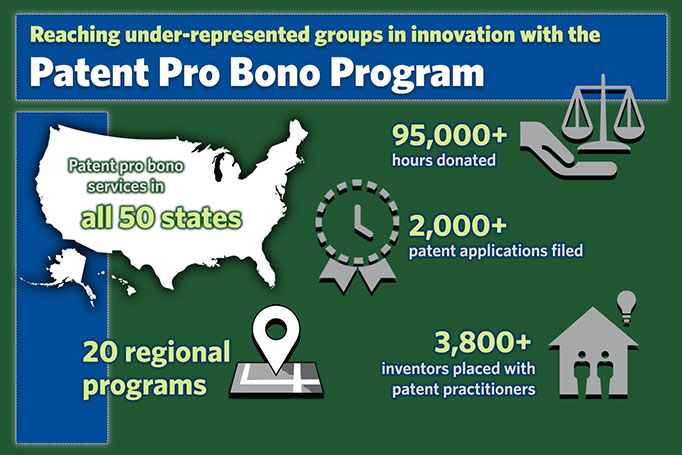
- 43% of program applicants
identified their gender as female; which is much higher than the proportion of
female inventors named on U.S. patent applications (13%);
- 35% of applicants identified
as African American or Black;
- 13.8% of applicants
identified as Hispanic;
- 7.9% identified as being a
veteran;
- 6.1% identified as either Asian, Pacific Islander, or Hawaiian Native, exceeding existing proportions in the U.S. population; and
- 1.6% identify as American Indian or Alaska Native.
Those are real numbers, real results. Real people benefiting from resources and opportunity, which yields robust, inclusive innovation that makes our country stronger.
There is a consistent theme that runs through our USPTO pro bono programs – providing critical assistance to under-resourced inventors, serving as the bridge to an inclusive innovation economy. By expanding access to pro bono legal services, we can help more under-resourced and underrepresented innovators protect their ideas and bring them to impact. And with the recent passage of the Unleashing American Innovators Act (UAIA), we are poised to build upon these programs, and expand their reach to provide more resources, services and opportunities.
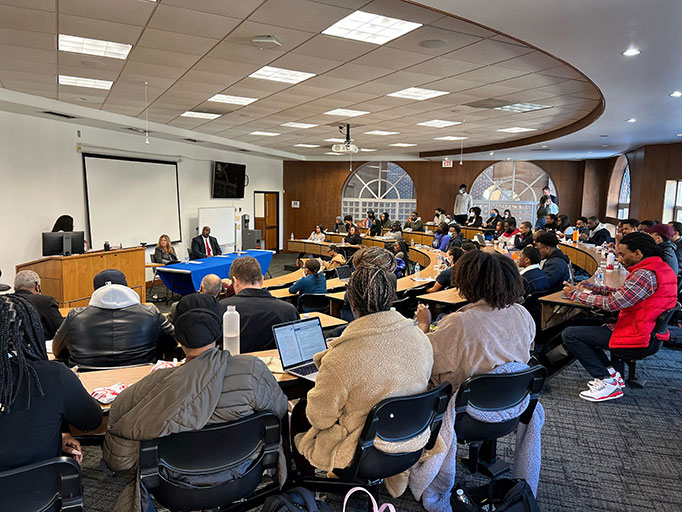
To that end, we encourage inventors and practitioners to participate in our upcoming listening sessions regarding our patent pro bono program (inventor session is June 5; practitioner session is June 7). These sessions will help inform the study we are undertaking on pro bono IP services as part of the UAIA. It is important to hear from you so that we can find ways to improve the services of our regional programs so that they best serve those who use the services.
When we meet people where they are, we bring more people into the innovation ecosystem. That is one of our top priorities. Thank you to all who help make our pro bono programs a success. To entrepreneurs and inventors – please learn more about our programs, and the many ways that the USPTO can help you on your journey.
Posted at 08:42AM May 22, 2023 in USPTO | Comments[1]
With artificial intelligence speeding the innovation process, what does that mean for invention and a properly balanced patent system?
Blog by Kathi Vidal, Under Secretary of Commerce for Intellectual Property and Director of the USPTO
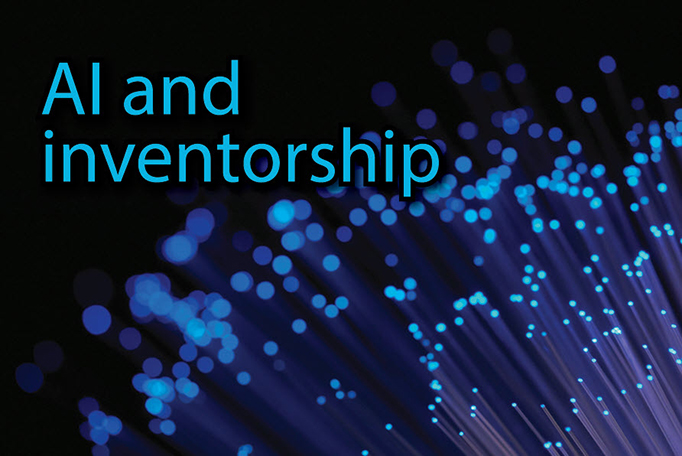
Artificial intelligence (AI) is one of the most powerful technologies of our generation, and it presents big opportunities and risks. At the USPTO, we are working on the responsible introduction of new AI into our workflow and organizational excellence, and are working across government and closely with the Department of Commerce on AI.
Through our AI and Emerging Technology (ET) Partnership, we are also looking closely at the growing role of AI in innovation and its potential to dramatically affect our lives, improve our country’s competitiveness, economic prosperity, and national security. Our AI/ET Partnership supports the Biden Administration’s whole-of-government approach to AI, including the National AI Initiative to advance U.S. leadership in AI.
As AI assumes a larger and larger role in innovation, and given recent developments and the current trajectory in innovation in AI, we are presented with new questions. If an AI system can contribute to an invention at the same level as a human, is the invention patentable under current law? Does allowing AI systems to be listed as inventors promote and incentivize innovation? Should the USPTO require applicants to provide an explanation of contributions AI systems made to inventions claimed in patent applications? These are some of the questions we are asking in our recent request for comments on AI and inventorship.
For the last several years, the USPTO has been exploring these and other questions about the role of AI in innovation. And we know that role is increasing. We recently analyzed all of our patents to study the impact that artificial intelligence is having on technology development in the United States and the world. We found that 80,000 of our utility patent applications in 2020 involved artificial intelligence – 150% higher than in 2002. AI now appears in 18% of all utility patent applications we receive, and in more than 50% of all the technologies that we examine at the USPTO.
This data reinforces that AI is important in innovation in all industries, and from all regions of the country. And we know there are a lot of surrounding questions related to AI and inventorship.
AI has the potential to benefit our wellbeing in many ways, from revolutionizing the drug discovery and development process to helping address climate change. It also presents potential drawbacks, some of which we may not even yet recognize. It’s important that we take a measured approach and hear your feedback on these important issues.
That’s why we need your input on how the U.S. government should address AI-enabled innovations while ensuring that our laws and policies continue to encourage and incentivize innovation without unduly locking up advances that can be readily discovered with the use of AI. Our takeaways will shape our future work on AI and ET policy at the USPTO and will help inform the broader U.S. government’s approach to these critical technologies.
We have listening sessions coming up to learn about the impact of AI on the invention process and intellectual property on April 25 at the USPTO headquarters in Alexandria, VA, and on May 8 at Stanford University. You can attend both sessions either in-person or virtually, and we’ll make recordings available afterwards. And, planning is already underway for our next AI and Emerging Technologies (ET) Partnership event later this summer. There, we’ll focus on how we are responsibly using AI tools at the USPTO. You can find information about all these events on our AI and ET Partnership page of the USPTO website.
I hope you will join us at an upcoming listening session and encourage you to submit your feedback to the request for comments by May 15. We look forward to hearing from you!
Posted at 01:38PM Apr 18, 2023 in USPTO | Comments[11]
One year of bringing innovation to impact
Blog by Kathi Vidal, Under Secretary of Commerce for Intellectual Property and Director of the USPTO
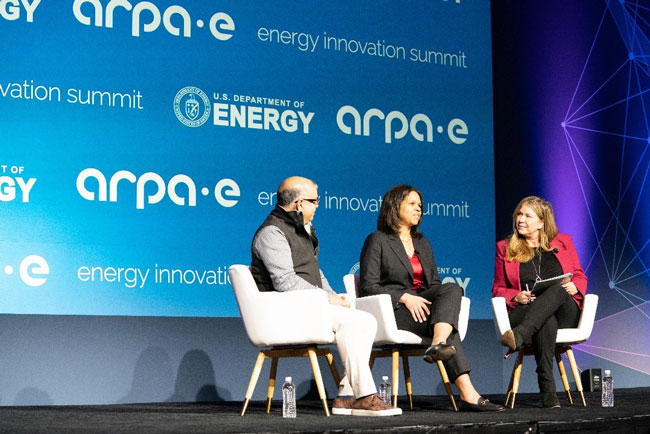
Director Vidal moderates a fireside chat with Mujeeb Ijaz, Founder and Chief Executive Officer, ONE (Our Next Energy), and Alicia R. Knapp, President and Chief Executive Officer, BHE (Berkshire Hathaway Energy) Renewables during the 2023 ARPA-E Energy Innovation Summit at the Gaylord National Resort & Convention Center. (Photo by Jay Premack/USPTO)
As a young girl, I went with my father to a garage sale and came home with an oscilloscope—I had always tinkered and experimented and was fascinated with the ability to measure and see signals that were not perceptible to the human eye. My love for science and engineering continued as I worked on military aircraft during and after college as one of two women in GE’s Edison Engineering Program. I transitioned to intellectual property (IP) law after seeing first-hand the way IP, including patents, trademarks, and copyrights, inspired innovation and transformed and grew companies. IP allowed me to combine my thirst for knowledge of all things scientific and technical and my love of innovation with my business and startup interests.
Now, one year into my role—at the intersection of IP law, policy, and innovation—I am focused on impact. I’ve spent the last year listening—in nearly 100 external stakeholder meetings, in internal small group listening sessions with over 1,500 USPTO employees, by reading your comments submitted via our requests for comments (RFCs) and your emails to my Engage with the Director inbox, in over 130 fireside chats, and in all my interactions across the country and the globe with inventors, entrepreneurs, and everyone who cares about making our IP ecosystem work for all. I care deeply about making data-driven decisions and getting it right.
If this last year was about listening and gathering the input and data to make meaningful, sustainable change, 2023 (and beyond) is about action.
What’s clear from conversations throughout this past year is that, more than ever, our nation needs the progress and growth that IP protections provide. We need a robust and reliable IP ecosystem that cultivates an innovation mindset and catalyzes inclusive innovation and entrepreneurialism—one that drives economic prosperity, U.S. competitiveness, supply chain resiliency, national security, and creative world problem-solving. We must continue to lead, and work closely with our allies, to realize our potential.
As set forth in our draft 2022-2026 Strategic Plan, the USPTO is advancing five strategic goals:
- Drive inclusive U.S. innovation and global competitiveness
- Promote the efficient delivery of reliable IP rights
- Promote the protection of IP against new and persistent threats
- Bring innovation to positive impact
- Generate impactful employee and customer experiences by maximizing agency operations
Below are just a few examples of the work we’ve done together to advance these goals throughout the last year and to lay the groundwork to make surgical changes to key areas of practice before the USPTO to preserve all that is working well while ensuring the system works even better for all of you.
We all have a stake in the success of this agency and the future of the American IP ecosystem. I will be working hard toward these goals with the talented and dedicated staff at the USPTO and with all of you.
With gratitude and optimism for an even brighter and more impactful year to come!
![]()
P.S. While this year is our year of action, we will never be done listening. You can reach out directly to me via Director@uspto.gov or through our Engage with the Director page.
2022-2023 Highlights: A Year in Review
We are building a more robust and reliable IP ecosystem that works for all
In order for IP to play the role our nation’s founders envisioned, we must create a more robust and reliable IP ecosystem in which innovators, entrepreneurs, investors, and all those building and growing companies and solving problems have confidence.
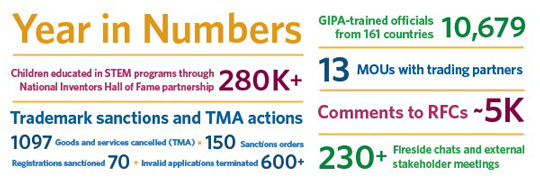
To that end, the team and I have been actively engaged with Congress and in the courts, including working closely with the Departments of Commerce and Justice, to provide technical support and to work to ensure our laws foster a strong innovation and entrepreneurship ecosystem.
We have worked to clearly communicate how the USPTO is making decisions based on past policy, guidance, and decisions, and to solicit feedback on where we can make surgical adjustments to strengthen our IP system. A few examples of this include:
- Creating more clarity and certainty in Patent Trial and Appeal Board practice in Director review and discretionary denials in America Invents Act proceedings, and with post-grant challenges generally
- Requested and received comments on our patent eligibility guidance and on how to ensure robust and reliable patents
We successfully implemented various strategies to crack down on trademark scams and fraud that affect the integrity of the trademark register and cause ripple effects across the trademark community, including:
- Conducting Trademark Modernization Act proceedings that have resulted in the cancellation of 1,097 unused goods or services out of the 1,119 goods or services challenged
- Implementing identity verification for all trademark filers to protect our system from scammers
- Registering USPTO marks to thwart fraudulent solicitations by scammers to trademark customers
- Issuing 150 orders terminating over 600 invalid applications and sanctioning 70 registrations for violations of our trademark rules of practice and website terms of service
We are dedicated to protecting businesses and their brands by informing consumers about the dangers and consequences of purchasing counterfeit or pirated goods through our partnership with the National Crime Prevention Council. Public service announcement campaigns for teens and tweens as part of our Go for Real campaign had a combined 78,435 airings on TV stations and over 570 million impressions.
We’ve also implemented internal improvements that have greatly benefited our operations. These include a new Patent Public Search tool to make searching for grants and applications much easier, an improved routing and classification process that better matches examiners’ expertise with the applications they examine, examiner training on new artificial intelligence (AI) tools to enhance prior art searching, and information technology systems upgrades for the benefit of our operations, to name just a few.
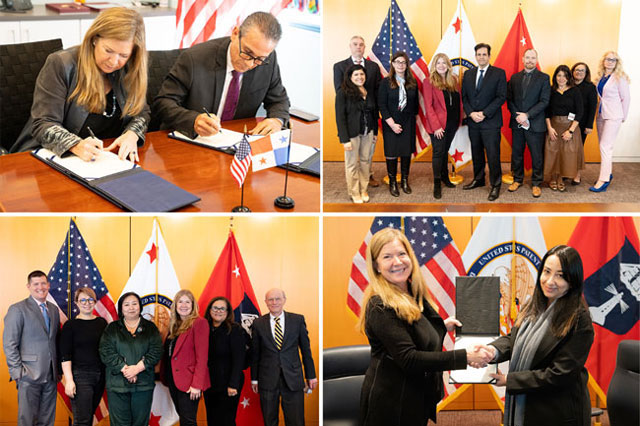
Director Vidal meets with foreign IP office leaders. Top row from left to right, signing of joint statement of intent on accelerated patent grant with the Directorate General of the Industrial Property Registry of Panama and signing of memorandum of understanding with the Canadian Intellectual Property Office. Bottom row from left to right meeting with the State Intellectual Property Service of Kyrgyzstan and signed memorandum of understanding with the National Service of Intellectual Property Rights of Ecuador.(Photo by Jay Premack/USPTO)
Our office has been extremely busy on the international front. I’ve met with over two dozen foreign IP office leaders and have embarked on an ambitious global agenda to strengthen our respective IP systems for the benefit of all communities. My engagement spanned the globe as I met with leaders of the G7 and trading partners from Latin America, Europe, and the Indo-Pacific region. A few highlights of this work include the following accomplishments:
- We entered into over a dozen cooperative agreements that identify concrete plans for promoting the transparency, accessibility, and reliability of our IP policies and practices.
- We developed and provided capacity-building programs, organized and conducted by USPTO attorneys, to help improve IP systems in key countries and regions to benefit U.S. stakeholders.
- Our Global Intellectual Property Academy (GIPA) conducted 222 programs this past year covering all areas of IP, training more than 10,679 officials from 161 countries and intergovernmental organizations, and over 6,526 small and medium-sized U.S. enterprises, U.S. government officials, and other U.S. stakeholders.
And we continue to work to harmonize global IP practices through cooperative agreements designed to improve IP systems and enhance the enforcement of rights with the IP offices of Japan, the European Union, Saudi Arabia, Malaysia, France, and Peru as well as the National Research Development Corporation of India and the World Intellectual Property Office.
The challenges we face today, such as climate change, public health, and sustainability, are global issues, and we are collaborating with our counterpart IP offices on global solutions.
We are fostering the development of new and emerging technologies to enhance American competitiveness
As we build an even more robust and reliable IP ecosystem, we are better positioning America to develop new and emerging technologies to enhance U.S. competitiveness, create U.S. jobs, and grow our economy.
We are looking closely at the growing role of AI and its potential to affect our lives dramatically. We launched our AI/ET (emerging technology) Partnership and recently published an request for comments on AI and inventorship (responses due May 15). And we are working on the responsible introduction of new AI into our workflow while we work across government through the Interagency Policy Committee on National Artificial Intelligence Strategy. We also worked with the U.S. Copyright Office on listening sessions related to the intersection of IP and non-fungible tokens (NFTs), and are focused on innovation in space and in space-adjacent markets through the U.S. Department of Commerce Commercial Space Coordinating Committee.
Where there are new markets, we are there.
We have also worked to ensure a robust and reliable patent system that incentivizes solutions to today’s global problems, including by:
- Supporting the White House Cancer Moonshot Initiative with our Cancer Moonshot Expedited Examination Pilot Program
- Working with the Food and Drug Administration (FDA) to cross-train our patent examiners in pharmaceutical and biologics fields as part of our joint effort to advance competition in the pharmaceutical marketplace
- Partnering with the U.S. Department of Agriculture to identify and solve for challenges small and family farms face
- Finding solutions to the causes and impacts of climate change through initiatives such as:
- Our newly announced Trademarks for Humanity Awards Program
- Our Patents for Humanity Green Energy category
- Expedited examination procedures through the Climate Change Mitigation Pilot Program
- Our partnership with the World Intellectual Property Organization’s WIPO GREEN Program
Through this important work, we are supporting and implementing Biden Administration priorities that seek to bolster our country’s resilience and prosperity, including in key areas such as the environment, climate, and health. The USPTO is also helping to advance the Biden Administration’s commitment to unleashing America’s potential. Furthermore, the USPTO is crafting a strong IP protection framework that will support the achievement of the goals of the Inflation Reduction Act, the CHIPS and Science Act, and other key legislation that will create and invest in innovation hubs, shore up our supply chains, and revitalize American manufacturing. This work lays the foundation for efforts to help future generations succeed and thrive.
We are expanding opportunities to bring more inclusive innovation to impact to advance our economy
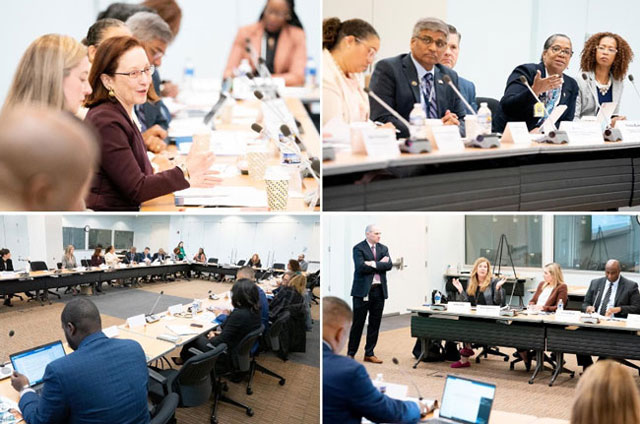
Director Vidal and the Co-Vice Chairs of CI² met in an ideation workshop to develop a whole-of-government approach to identifying key barriers to entry and potential solutions to help build an equitable, comprehensive plan to enable more Americans to access the innovation and entrepreneurship ecosystem and innovate in areas that are essential to America’s future. (Photos by Jay Premack/USPTO)
In order for our IP ecosystem to enhance U.S. competitiveness, create jobs, and grow our economy, we must bring more people into the innovation and entrepreneurship ecosystem and give them the support they need to bring their ideas to market.
Last year, we expanded our Council for Inclusive Innovation (CI²) and I joined the Economic Development Administration’s National Advisory Council on Innovation and Entrepreneurship (NACIE) as a Co-Chair to work across government and with the private sector to expand the innovation ecosystem, especially among under-represented and under-resourced groups and in key technology areas.
Under CI², we launched our First-time Filer Expedited Examination Pilot Program to assist qualifying independent inventors and small businesses with getting a patent faster and to help their businesses grow.
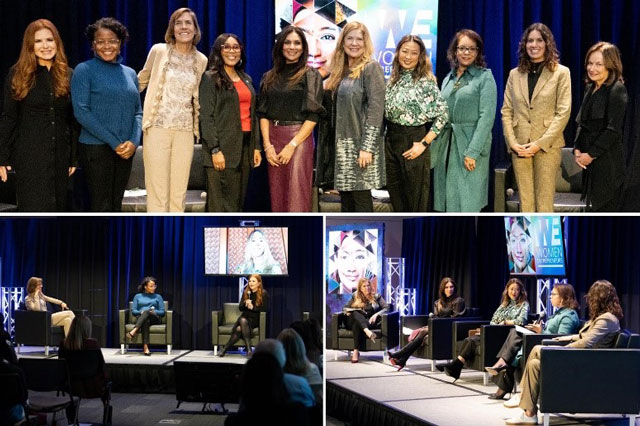
On November 30, 2022, the USPTO held the official launch event for Women’s Entrepreneurship (WE), a community-focused, collaborative, and creative initiative to encourage and empower more women founders across America. (Photos by Jay Premack/USPTO)
We are also digging deep in specific communities:
- Women entrepreneurs
- We co-founded, along with U.S. Secretary of Commerce Gina Raimondo, our WE Initiative to inspire and empower more women leaders to jumpstart their journeys of innovation.
- We are working with the Intellectual Property Owners Association and other associations to create a “mentorshIP” program that facilitates meaningful interactions between budding women entrepreneurs and successful women who can share lessons from their experiences.
- We issued our study on the geography of women in patents to better understand economic and socioeconomic correlations with patenting by women.
- Entrepreneurs of color
- We are working with historically Black colleges and universities and minority serving institutions on expanding tech transfer initiatives.
- We are more fully engaged with the Native American community on how we can best support innovation and entrepreneurship on tribal lands and elsewhere.
- Military and veteran entrepreneurs
- We have worked to support more active military, military family members, and veterans and to encourage them to bring their innovations to life, build successful businesses, and protect their creations with IP.
- We’ve met incredible people hustling to start new businesses and commercialize their products during events at Fort Bragg, MacDill Air Force Base, and the military innovation competition Dragon’s Lair 8.
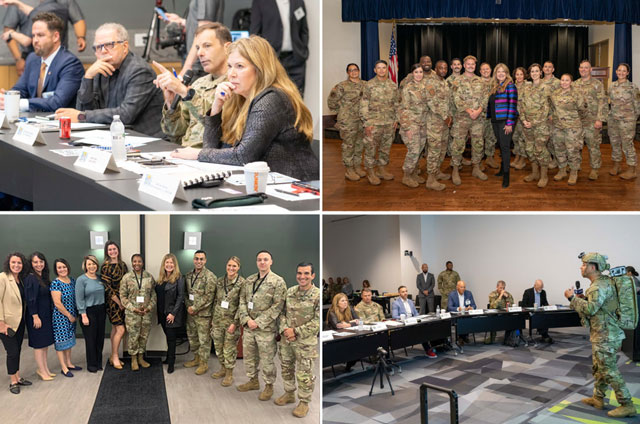
Director Vidal has met with service members and military family members at Fort Bragg and MacDill Air Force Base and participated in the Dragon’s Lair 8 competition finals at the University of South Florida. (Photos by Michael Cleveland/USPTO)
While we work to support our current pipeline of talent in America, we must also foster an innovation mindset in the next generation. Last year alone, more than 280,000 children participated in invention education activities through our partnership with the National Inventors Hall of Fame’s Camp Invention summer camps and other innovation programs. We also launched a new online resource, EquIP HQ, which features online games, interviews with inventors, and lesson plans for the classroom, and we hosted events throughout the year for K-12 educators, including monthly webinars, our annual National Summer Teacher Institute, and our first ever Master Teacher of Invention Education Program.
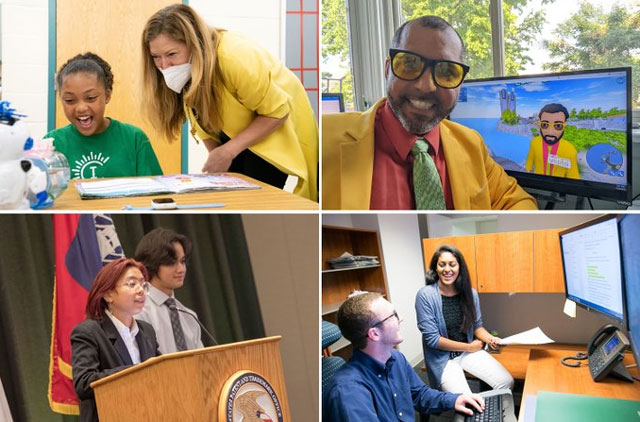
From our partnership with the National Inventors Hall of Fame, which provided hands-on learning to over 280,000 K-12 students last year through programs like Camp Invention, to our National Summer Teacher Institute, a yearly program that gives K-12 teachers in-depth training on integrating invention education into their classrooms, the USPTO is reaching students where they are.
As we expand participation in the IP ecosystem, we are doubling down on our pro bono legal services (free to qualifying applicants), which will open the doors for additional support and representation for innovators while maintaining the high quality of representation before the USPTO.
We have also expanded our free resources and pro bono programs. Over the past year:
- Our free services webpage has amassed over 77,000 views, ranking it among the most popular pages on our website.
- We launched the Trademark Trial and Appeal Board Pro Bono Clearinghouse Program.
- We launched the PTAB Pro Bono Program.
- We expanded the Law School Clinic Certification Program.
- We solicited feedback on ways we can expand the patent bar, create a design bar, and expand opportunities for practice before the PTAB.
When we meet people where they are with our Patent Pro Bono Program, 43% of those we assist self-identify as women, 35% as identify African American or Black, 14% identify as Hispanic American, 8% identify as veterans, 5.7% identify as Asian American or Native Pacific Islander, and 1.5% identify as Native American. With this kind of data, we know that innovation is everywhere, and through our continued commitment to meet people where they are, we will make our great country stronger and more resilient.
We are excited about what the rest 2023 will bring and look forward to making a meaningful impact for our country and all of you!
Posted at 09:53AM Apr 13, 2023 in USPTO | Comments[13]
Spotlight on Debbie Stephens: Driving change and modernization in information technology systems
Guest blog by Deborah Stephens, Deputy Chief Information Officer, United States Patent and Trademark Office
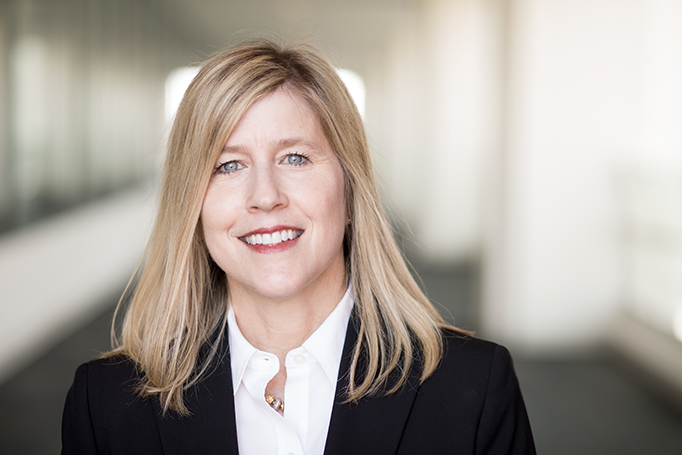
I am thrilled to continue to drive change in our information technology area and leverage my experiences to ensure OCIO aims for better ways to solve customer service issues, operates with more speed, and delivers powerful software and services. I am a firm believer that anything we do can be improved. We survey our staff for their ideas, we empower them to try, fail, learn, and succeed, and then we recognize them for the good work that they do. I am committed to listening to my staff and welcoming their ideas for change, so that we can keep improving for our employees and delivering value to our customers.
As a daughter of a strong mother, a wife, and a mother of a smart strong woman, I have been blessed to have many women role models during my life–none more important than my mother. Married at age 21 to a Navy pilot, and quickly uprooting herself from her small town in Horton, Kansas to join him around the world, my mother adapted to new cultures and languages all the while raising four children, managing the household, and the official duties expected of an officer’s wife. She is smart, strong, kind, funny, and the steadfast rock that our family has been built on. It is my honor to call myself her daughter. I learned love and compassion from her, and I learned to always tell the truth and to never stop trying to do better and learn more. I learned from her that a girl can do anything that a boy can do, and I went on to have a successful college experience as an Academic All-American college athlete at George Mason University, playing Division 1 softball while earning my Bachelor of Arts degree. I then went on to receive a Master of Human Resource Management degree from the George Washington University.
Additionally, I have met women in both my personal and professional career–such as the stay-at-home moms I worked with for 15 years in support of Girl Scouts at Fort Hunt Day Camp, organizing troop activities and selling Girl Scout cookies; their logistical expertise, ability to motivate and lead girls, many times doing it with a baby on the hip, and always with good humor—that have shown me how to evaluate situations from multiple and diverse lenses. I strive to learn from each encounter.
At the USPTO, I have had the fortune to work with and get to know women leaders from all areas within our organization. Women that have made their mark and gone on to new areas both within and external to the government, as well as women that have stayed for long periods of time at the USPTO. I have learned to be tenacious, detail oriented, to expect the best from everyone, and to always assume noble intent first and foremost.
Women’s History Month is meaningful to me in that it causes us to take a moment to acknowledge and reflect on the contributions that women have had towards the growth and prosperity of our country. The intellectual property community we support here at the USPTO has always had our fair share of smart and creative and industrious women that saw a need for a new way of doing things. These women were often granted patents and trademarks for inventions, businesses, and brands that contributed to the commerce and advancement of the U.S. Many great women are showcased during this month, and I want to acknowledge them. I also want to acknowledge women that may never have their name on a patent or trademark, the women that parent, the women that teach and support each other. And finally, the young women who are paving the way as the next generation of innovators. Together, we are a strong vibrant community that does great things–some large, some small—with empathy and concern for each other.
This blog is part of a series highlighting leaders across the Department of Commerce for Women's History Month.
Posted at 08:52AM Mar 13, 2023 in USPTO | Comments[5]
Apply by March 31 to the USPTO’s National Summer Teacher Institute!
Blog by Kathi Vidal, Under Secretary of Commerce for Intellectual Property and Director of the USPTO
Are you a teacher looking to equip your students with the confidence to solve real world problems? The USPTO’s National Summer Teacher Institute on Innovation, STEM and Intellectual Property (NSTI) is an excellent opportunity to do just that!
NSTI is an annual hands-on professional development program for K-12 educators to learn classroom techniques that will foster and unleash the innovator in every student through invention education. We are accepting applications from educators until March 31 to join us for this year’s summer session from July 16-21 in St. Louis. The program has no fee for participants, and our NSTI frequently asked questions include additional information on travel and lodging.
Intellectual property touches nearly every sector of daily life, so the concepts in the NSTI program are applicable across all educational fields. And the value goes beyond the classroom – our recent study found that IP-intensive industries account for 41% of the U.S. gross national product, while workers in IP-intensive industries earn higher wages and are more likely to have better benefits.
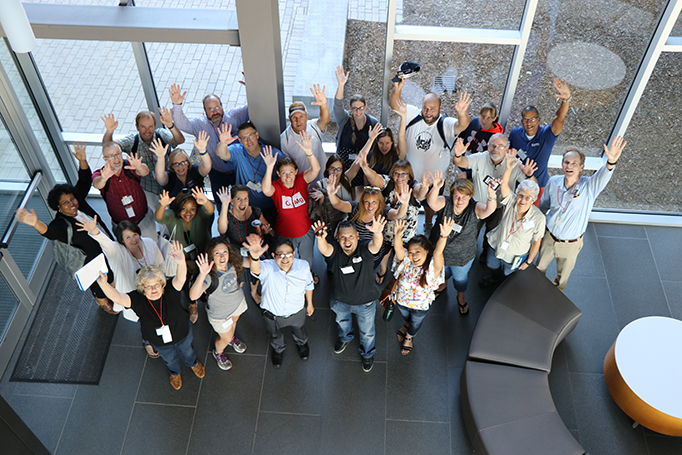
At NSTI, you will build the skills you need to incorporate key intellectual property (IP) and STEM topics into your curricula, develop strategies to help students understand and appreciate the importance of innovation and creativity, and, where feasible, commercialize their own inventive works! You will have the opportunity to work with USPTO experts to explore patents, trademarks, copyrights, and trade secrets. You will also have access to several “maker spaces” focused on various technologies, from additive manufacturing - where you can use industrial 3D printers and laser cutters, to unmanned aerial systems, where you can control a drone by talking to it, using gestures, or through virtual/augmented reality. You can learn the latest on urban water research and preventing public health disasters, as well as engineering next-generation technologies to bridge the gap between humans and technology, and much more. What you learn will help you design and build prototypes as part of your week-long invention project. Sound fun? It is!
In addition to the hands-on experience, you will also receive valuable resources to take back to your classroom. These resources include teaching materials, lesson plans, and activities that align with national standards and can be customized to meet the needs of different grade levels, subject areas, and abilities. And by making connections with other educators from around the country, you can continue to share best practices and ideas for classroom instruction.
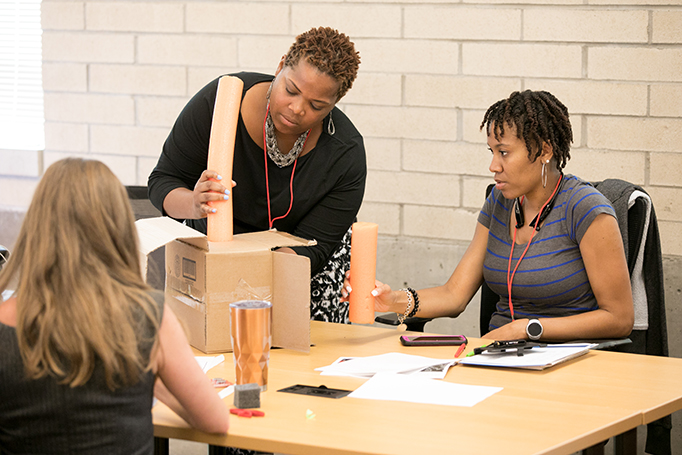
One of the most significant benefits of attending NSTI is the impact it can have on your students. You’ll leave with more tools to help them develop the critical thinking skills they need to succeed in the 21st century. You can also inspire them to pursue careers in STEM fields, where the demand for skilled workers is high. You might even lead them to earning a patent for an invention!
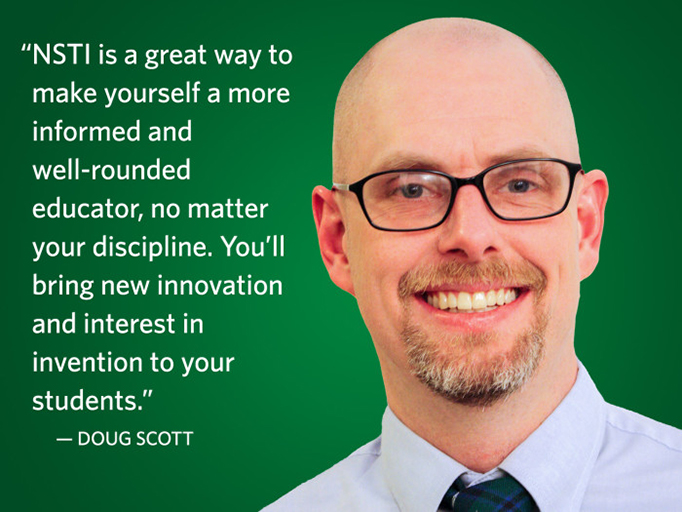
By participating in NSTI, not only will you gain valuable knowledge and skills, but you will also become part of a network of educators committed to making a positive impact on your students. Don't miss out on this exciting opportunity to enhance your teaching skills and inspire the next generation of innovators and creators.
We look forward to seeing your application!
Posted at 08:42AM Mar 09, 2023 in USPTO |
Increasing transparency, boosting competition, and supporting innovation can deliver better choices for farmers in the seed marketplace
Joint blog by Thomas J. Vilsack, Secretary of Agriculture, and Kathi Vidal, Under Secretary of Commerce for Intellectual Property and Director of the U.S. Patent and Trademark Office

Photo courtesy of USDA
The President outlined a multi-point plan to increase competition in the seed and agriculture space in his July 2021 Executive Order on Promoting Competition in the American Economy. Included in that plan is a call for the U.S. Department of Agriculture (USDA), in consultation with the U.S. Patent and Trademark Office (USPTO), to submit a report to the White House Competition Council on relevant concerns and strategies to help ensure “that the intellectual property system, while incentivizing innovation, does not also unnecessarily reduce competition in seed and other input markets.”
The Biden-Harris Administration, including the USDA and the USPTO, recognizes the importance of innovations in the seed and agricultural space, including ones that will mitigate climate-related disruptions to our food and agricultural systems. With more choices, and plant varieties tailored to local circumstances, farmers may gain potential revenue. In addition, diversifying variety development and production of seeds and other planting stock will make supply chains less vulnerable to disruption, give incentives to new market entrants to compete, and establish a fairer and more competitive market.
The investment in innovation in the seed and agriculture industry is made possible in part due to our intellectual property laws. The foundations of these laws were written into the U.S. Constitution by our nation’s founders, and innovators can utilize patents and plant variety protection to recoup and benefit from their investments during the limited terms provided. Indeed, USDA started its life as the then Patent Office’s Division of Agriculture, which for the first decades of our country distributed free seeds to farmers to promote agricultural production. Seeds were recognized over time as part of the intellectual property system through the Plant Variety Protection Act of 1970 and more recently through a series of court cases that recognized the availability of utility patents for seeds.
Today, the intellectual property system affecting seeds is diverse and robust. For example, the Plant Variety Protection Act permits farmers to save seeds for their own use and permits plant breeders to conduct research to develop the next variety. Our patent laws also allow for and encourage the disclosure of inventions, and for others to build on those innovations. These delicate sets of balances aim to reward and incentivize those who do the work to create original innovation, as well as protecting the public interest in continued innovation and fair competition.
But more must be done to ensure that the intellectual property system addresses the needs of agriculture today. While reliable intellectual property protection can incentivize seed and agricultural innovations, our patent system must not be used to unnecessarily reduce competition beyond what is reasonably contemplated by the law.
To further the objectives of President Biden’s Executive Order, the USDA recently completed its report in consultation with the USPTO Director, and the two agencies exchanged letters outlining numerous initiatives they will undertake to execute the President’s agenda. Under a newly established USDA-USPTO Working Group on Competition and Intellectual Property, these initiatives will strengthen our relationship and expand the resources available for assessing patentability and addressing instances of patents being used to unnecessarily reduce competition.
The joint initiatives of the new Working Group include:
1. exploring joint USPTO-USDA opportunities for collecting broader stakeholder input from researchers, plant breeders, farmers, and others in the seed and agricultural input markets,
2. exploring initiatives to enhance the quality of the patent examination process for innovations related to agricultural products and processes, including opportunities for enhancing prior art search capabilities and providing additional training and guidance to patent examiners,
3. collaborating on initiatives that enhance the transparency of IP information for agriculture-related innovations and assess availability and viability of patented and off-patented germplasm, and
4. considering and evaluating new proposals for incentivizing and protecting innovation in the seed and agricultural-related space, including the broader adoption of research or plant breeders’ exemptions when U.S. utility patents cover seeds.
The USPTO is eager to work with USDA’s new Farmer Seed Liaison to facilitate greater interaction between the agricultural sector and the IP system. The USPTO and the USDA will further collaborate to develop policies aimed at protecting and promoting U.S. innovation in the seed and agriculture space while advancing competition that will support farmers and supply chain resilience.
We invite the public to participate in this process through upcoming outreach events and listening sessions, and we look forward to hearing a diversity of views on these important topics.
For more information on the Biden Administration’s initiative in the seed space, please go to the USDA’s seed competition website.
Posted at 01:08PM Mar 07, 2023 in USPTO |
Free resources inventors and entrepreneurs need to know about
Blog by Kathi Vidal, Under Secretary of Commerce for Intellectual Property and Director of the USPTO
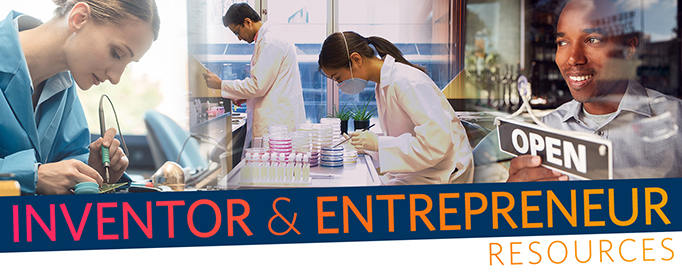
Patent and trademark basics
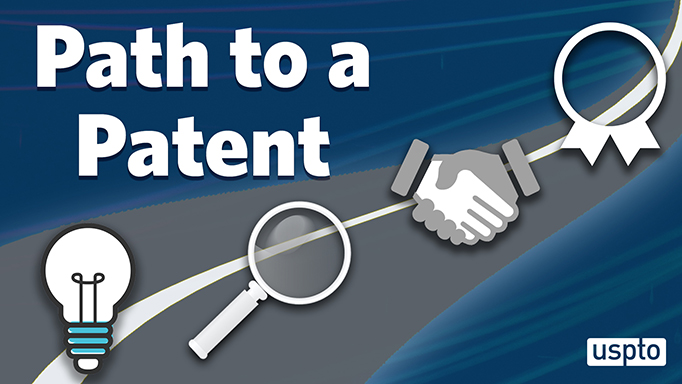
In addition, our Trademark Basics series is in its 10th cycle and is offered regularly throughout the year. Each module focuses on different aspects of trademarks and the registration process, from filing and examination to post-registration requirements for keeping your registration alive. And, of course, time for your specific trademark questions.
Patent and Trademark One-day Boot Camps
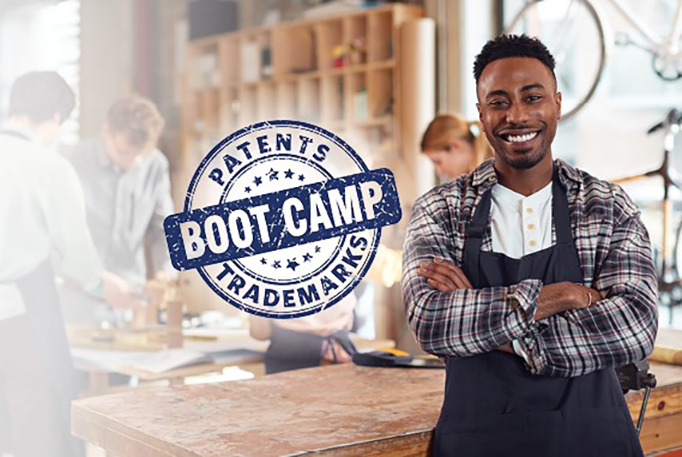
Free legal assistance (pro bono) programs
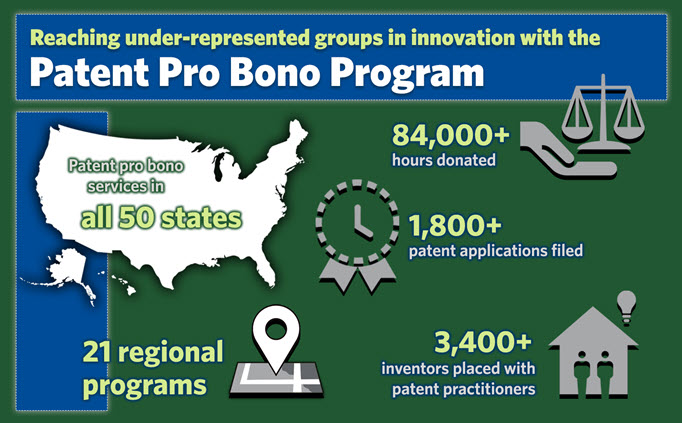
Law School Clinic Certification Program
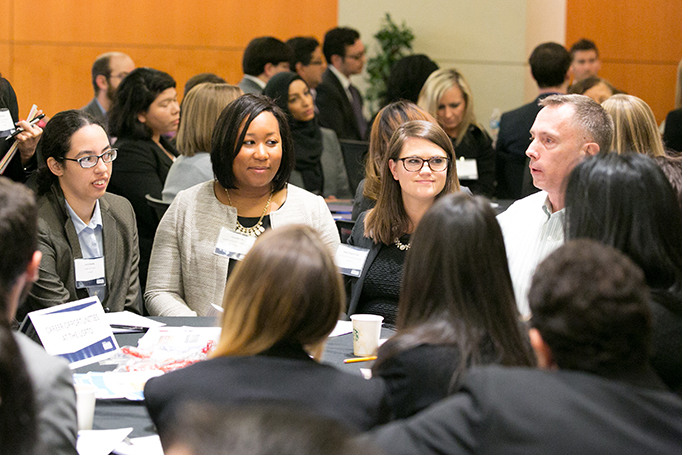
Additionally, our Law School Clinic Certification Program includes over 62 participating law schools that provide free legal services to eligible members of the public. Each year, students at the participating law schools assist numerous inventors, entrepreneurs, and small businesses with preparing, filing, and prosecuting patent and trademark applications. We recently announced that we have extended the submission deadline for the program to January 5, 2024, to encourage more law schools to join. With greater law school participation, we can make an even greater impact. Find out more about the Law School Clinic Certification Program and how your law school can apply to participate in the program.
Patent and Trademark Resources Centers (PTRCs)
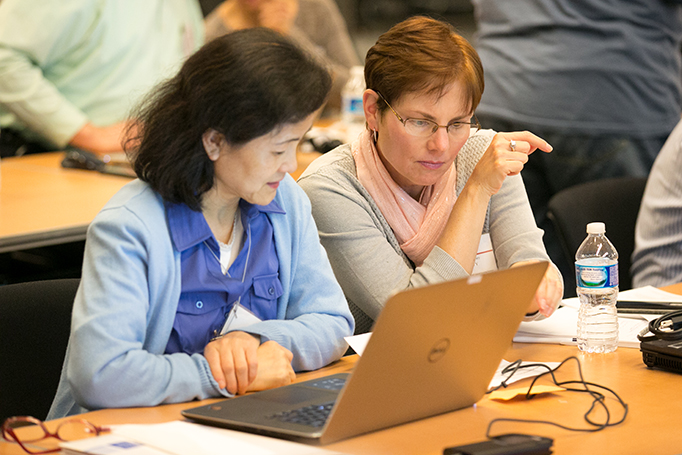
Another way to connect directly with someone for assistance with your IP questions is through our Patent and Trademark Resource Centers Program (PTRC). Located in more than 80 public, state, and academic libraries across the country, PTRC library staff are trained by the USPTO on how to use search tools to access patent and trademark information and connect individuals to our resources. They provide the human touch that no webpage or legal book can in helping inventors and small businesses find the information they need to protect their intellectual property. And very soon, the PTRCs will be providing training in even more locations. Find a PTRC near you!
Empowering Women’s Entrepreneurship (WE)
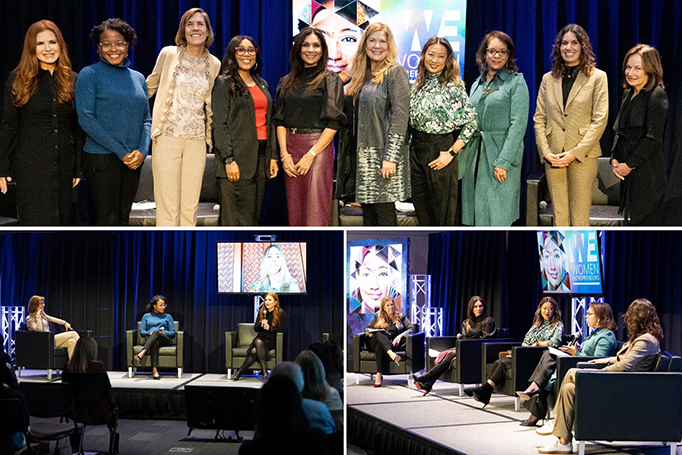
Launched in November 2022, our Women’s Entrepreneurship initiative is a community-focused, collaborative, and creative initiative to encourage and empower more women business founders across America. This program, which builds on the proven success of the USPTO’s Women’s Entrepreneurship Symposium, features advice from those who have made it as well as resources to help women protect their intellectual property, fund their ideas, and expand their network of mentors and advisors. WE is near and dear to my heart, as a former business owner, investor, and adviser.
These are just a few of our free resources available to inventors and entrepreneurs. To find more,
• Visit our Access Free Services page and Inventor and Entrepreneurs Resources page,
• Learn about upcoming programs on our events page,
• Subscribe to our email alerts to be the first to know the latest updates, or
• Contact us with questions or for more information!
Our goal is for the innovation system to be as diverse and inclusive as our country by working to provide equitable access for all. We hope to hear from you or see you at one of our upcoming trainings and events!
Posted at 12:23PM Mar 02, 2023 in USPTO | Comments[1]
Beyond Baker’s list: Black innovation then and now
Guest blog by Rebekah Oakes, Acting Historian, USPTO
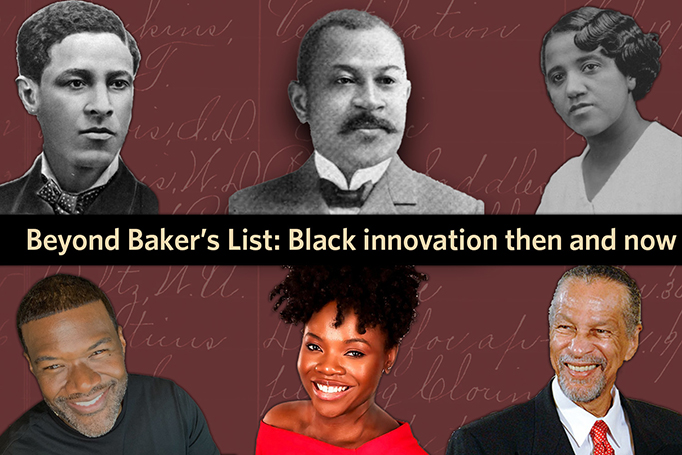
In the 1880s, second assistant patent examiner Henry E. Baker took on a project that would become his legacy: compiling the first list of African American patent holders. Over the next few decades, Baker’s list would grow to several hundred entries, an immense repository of contributions by Black inventors to the technological progress of humanity and a powerful record of the public quest for racial equality at the turn of the 20th century. Thanks to Baker’s tireless research, we have at our fingertips a vast repository of Black innovation throughout early U.S. history. Keep reading to learn how the inventors on Baker’s List have been changing the world for generations as creators, disruptors, and trailblazers in their respective industries, and how Black excellence in invention continues today.
One of the inventors on Baker’s List was Jan Matzeliger, who in 1883 changed the shoe industry forever with his automatic lasting machine. Born in Dutch Guiana (now Suriname), Matzeliger immigrated to the United States at the age of 20 and took a job operating a shoe-stitching machine. After watching the work of hand lasters at the factory, he set out to make the process of joining the sole to the upper part of the shoe more efficient. Matzeliger built his first model out of wooden cigar boxes, elastic, and wire, a prototype so complex that patent examiners had to see it in operation to understand how it worked. Matzeliger’s invention could produce 700 pairs of shoes per day, up from 50, making quality shoes widely affordable for the first time.
About 15 years later, in 1898, Lyda D. Newman received a patent for a hairbrush with fine synthetic bristles and an inner chamber that trapped dust and dirt. Reflecting expertise collected from her career as a hairdresser in New York City, Newman’s invention paved the way for other Black innovators to further revolutionize the hair-care industry, including 2023 National Inventors Hall of Fame inductee Marjorie Stewart Joyner.
Newman’s innovative mind blazed a trail for others to follow in many important areas. In the 1910s, she led efforts by the Woman Suffrage Party (WSP) to involve Black women in the struggle for the vote. Having built a grassroots suffrage campaign in her Manhattan neighborhood of San Juan Hill, she was approached to lead the effort for women’s suffrage among Black New Yorkers in 1915. The New York Times and other papers took notice of some of Newman’s strategies, including providing a daycare at WSP headquarters in San Juan Hill so that mothers wouldn’t have to choose between childcare and political involvement.
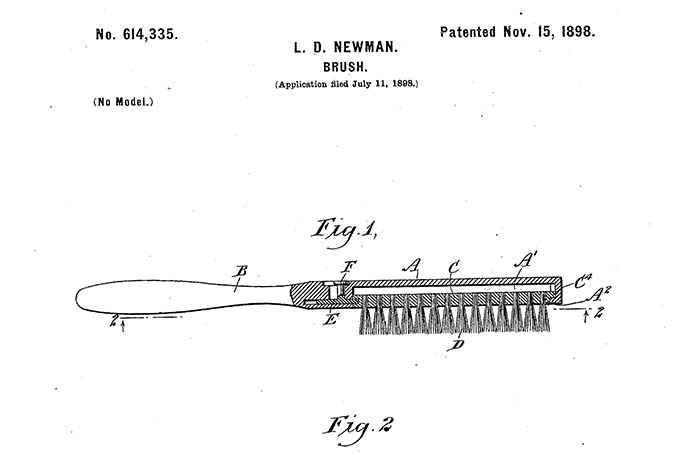
Studying Baker’s list reveals inventor after inventor whose experiences helped them identify and solve problems, building upon existing products and innovations with their ideas. Alfred Cralle, a porter in a Pittsburgh hotel, invented the one-handed ice cream scoop still in use today. Sarah Boone, a dressmaker from New Haven, Connecticut, patented an improved ironing board shaped specifically for bodices and sleeves. If you use a lawn-mower attachment to collect grass clippings, you have Daniel Johnson of Kansas City, Missouri to thank. And, the eye protector patented by Powell Johnson of Barton, Alabama helped firefighters and furnace workers protect their eyesight from the bright glare of the fire.
The triumphs of these individuals reflect a time where, as the nation industrialized, more Americans were inventing than ever before. But Black innovators faced numerous challenges, including racist attitudes that prevented commercialization of their products. “We can never know the whole story,” Henry Baker lamented in his notes, as many inventors chose not to reveal their race, fearing it would harm the commercial value of their invention.
Progress was hard-fought and uneven. Nevertheless, the inventors on Baker’s list laid the foundation for today’s change-makers, some of whom joined us this month to tell their stories during our Black Innovation & Entrepreneurship programs:
• Dissatisfied with the workout grip devices available on the market, Cornell “Chico” Conaway started Gainz Sportsgear after designing and patenting Load N Lock Grips, which are longer and thicker than traditional grips.
• With over 250 patents, Jim West, a winner of the National Medal of Technology and Innovation, is best known for his invention of the electret microphone, technology that represents 90% of the microphones produced annually and found in everyday items like your cell phone.
• Tope Mitchell used her PhD in sociology to found Reflekt Me, a company that hyper-personalizes eCommerce sites to create inclusive communities, allowing fashion and beauty brands to engage with 100% of their digital buyers.
During our final Black Innovation & Entrepreneurship event of 2023 on February 24, we premiered the documentary short "America’s Ingenuity," created in partnership with the National Inventors Hall of Fame (NIHF). The film focuses on Richard F. America, one of the youngest Black inventors on Baker’s list, and features an interview with his son. We also announced the USPTO will rename its Public Search Facility after Henry Baker, honoring both his dedicated career as a civil servant and his contributions to the historical record.
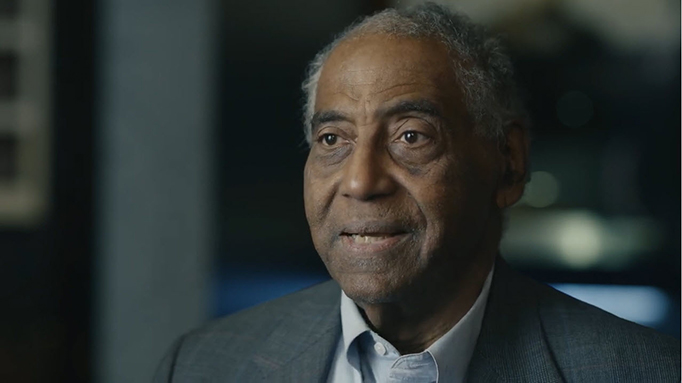
As we learn more about the inventors on Baker’s list, we will continue to share their unique stories. In the style of Henry Baker, we are also using crowdsourcing to learn as much as we can. Here’s how you can help us document and recognize the history of Black innovation:
• If you are the descendant of a Black inventor, or know of a past innovator who lived or worked in your community, please reach out to historian@uspto.gov.
• Nominate a world-changing innovator to receive the National Medal of Technology and Innovation, the nation’s highest honor for technological achievement.
• Consider nominating an inventor to be included in a future class of the National Inventors Hall of Fame.
We can never know the whole story, but by studying and expanding on Baker’s work, we can get a much fuller picture of the Black creators, trailblazers, and disruptors who helped invent modern America. We are proud to honor these innovation heroes.
Editor's note: The accomplishments of Henry Baker and the pioneering inventors on Baker's list were recently featured in a Washington Post article.
Posted at 08:55AM Feb 28, 2023 in USPTO |
EquIP HQ: Empowering students and teachers with invention and intellectual property skills
Blog by Kathi Vidal, Under Secretary of Commerce for Intellectual Property and Director of the USPTO
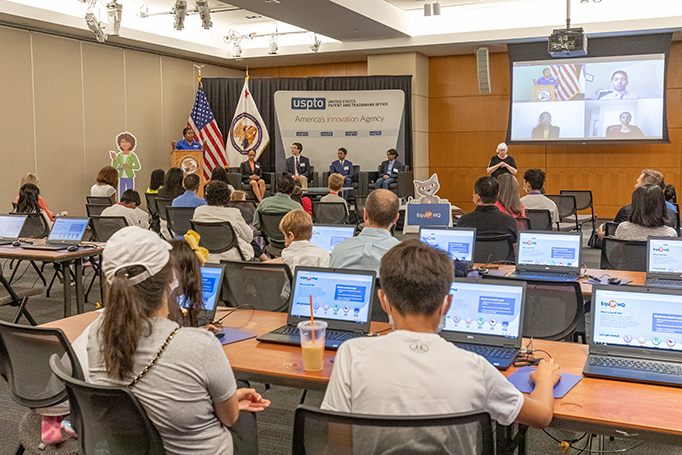
Do you know which president had a patent? Do you want to design your own trademark?
These are just some of the questions and fun activities posed by EquIP HQ, the USPTO’s new invention education resource that we are thrilled to launch today. The online platform, created by and for the USPTO with support from digital education contractor Second Avenue Learning, provides free tools to teach students real-world invention and intellectual property (IP) skills.
Whether you’re a school administrator, teacher, student, parent, or caregiver, EquIP HQ has something for everyone. You can watch inspirational and educational videos, learn about IP throughout history, or find lesson plans, all while learning how you, too, can innovate and change the world. Activities are tailored to students’ grade level and range from online games to learning about IP, to hearing stories from young inventors, to more complex activities like learning how patent claims are drafted.
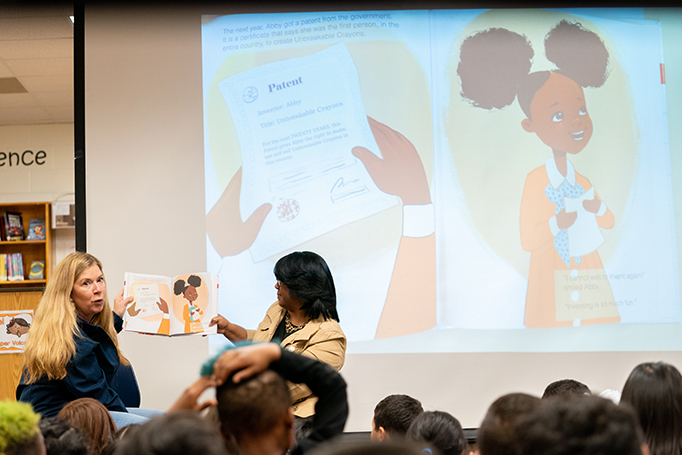
The primary goal of EquIP HQ is to raise intellectual property awareness, knowledge, and understanding among K-12 learners and educators. Invention education and learning about the importance of IP is for every student, and empowering them to recognize the innovator within is a core part of our mission at the USPTO. Reaching students at an early age with fun and engaging content to learn how to invent and protect their creations is critical to inclusive innovation. Our hope that each student who uses EquIP HQ will realize that their ideas are powerful and can change the world.
Research has shown that inventing and entrepreneurship are crucial to the United States’ economic success; however, it has also revealed significant disparities in opportunities to innovate across the country. If we, as a nation, can build an innovation economy that more closely reflects the diversity of our citizens and equally enables everyone to invent, start businesses, and access IP protection, just think of the problems we would solve! The USPTO is dedicated to advancing this endeavor.
It is also crucial that we take a united approach to empowering all innovators. That is why we strongly support the U.S. Department of Education’s You Belong in STEM initiative, the National Science Foundation’s INCLUDES National Network, and we work closely with many other educational organizations and minority serving institutions to advance inclusive innovation at an early age.
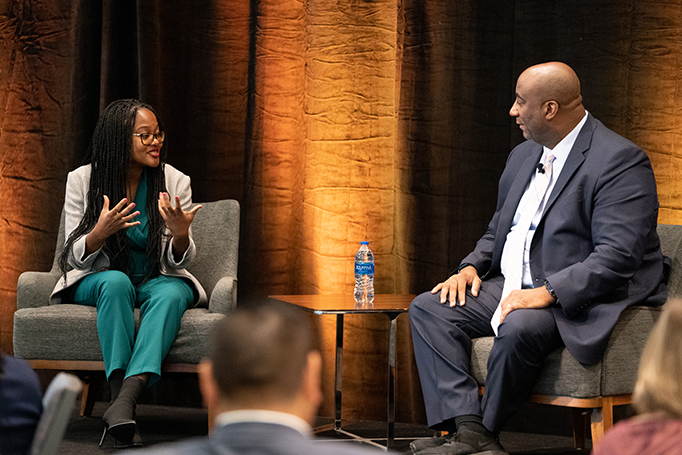
We love the work we do with educators across the country and are always inspired by their creativity. If you are a K-12 educator interested in incorporating more fun and interactive intellectual property lessons in your classroom, we want to meet you! We host monthly professional development webinars on the last Tuesday of each month that offer insightful stories, tips, and tricks for K-12 educators to integrate invention activities into their STEM/STEAM curriculum. Our February 28 webinar will focus on EquIP HQ.
We will also be showcasing EquIP HQ at events around the country! Look for us at the South by Southwest EDU Expo in Austin, March 6-8. In addition, we are now accepting applications for our popular National Summer Teacher Institute (NSTI) on Innovation, STEM, and IP. NSTI is a multi-day professional development opportunity for K-12 educators to boost their knowledge of making, inventing, and intellectual property concepts, including using tools like EquIP HQ. The deadline to apply is March 31, and the program will take place July 16-21 in St. Louis. And learn more about all our resources for kids and educators, upcoming events, and outreach efforts on our Office of Education page.
We want to hear from you! Let us know what you think of EquIP HQ by emailing your feedback and suggestions to education@uspto.gov.
Posted at 08:55AM Feb 23, 2023 in USPTO | Comments[3]
Black History Month: Advocating for and supporting diversity, equity, and inclusion at the USPTO
This blog post is part of a series showcasing the diverse African American leaders from across the U.S. Department of Commerce in honor of Black History Month.
By James O. Wilson, Assistant Regional Director of the Midwest Regional Office of the USPTO
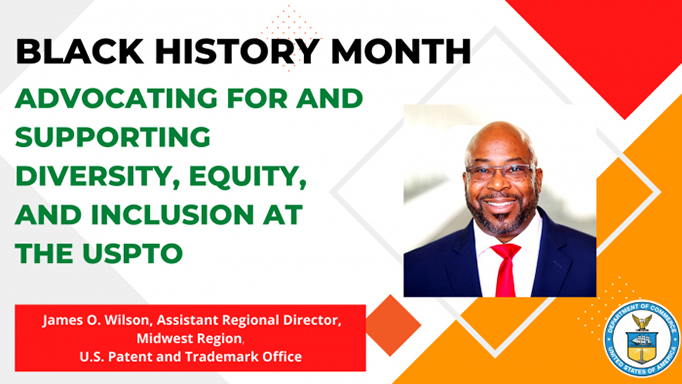
A Look Back
Born in the early 1960s, I am truly a product of the late 20th century. I started elementary school at the end of the civil rights movement in the late 1960s and in the 1970s, and I watched the Vietnam War casualty numbers reported on the news at dinner time every night. My public-school education in a “post-civil rights movement era” included being bussed to elementary and middle school where I developed relationships with friends from divergent backgrounds.
My college career started at “The Mecca” of Historically Black Colleges and Universities, Howard University in Washington, D.C. in 1980. There, I developed a strong sense of self identity and established the foundation for the goals for my life. I pledged a Black Greek Letter Organization, Alpha Phi Alpha Fraternity, Inc., whose motto “manly deeds, scholarship and love for all mankind” has become indelibly ingrained in my mind, heart, and spirit. A year after graduating from Howard, I entered the University of Michigan where I received my Masters of Science degree in Cellular and Molecular Biology. That same year, I was hired to work in a biotech lab that supported the work of Dr. Anthony Fauci, where I sequenced and isolated pieces of the HIV genome that were made available to his lab for testing.
Opportunities at the USPTO
In March of 2017, I returned to Michigan and accepted a detail position in Detroit at the USPTO’s Elijah J. McCoy Midwest Regional Office as a resource supervisor, helping new examiners understand their role and responsibilities. That first year, I agreed to serve as the acting assistant regional director, and when the regional director moved on from the office, I assumed the role of acting regional director for over a year. As the current Assistant Regional Director. I am so fortunate to work with a team whose goals include engaging and serving minority, women, and veteran intellectual property stakeholders. I appreciate being an active participant in making a difference in the intellectual property ecosystem, and educating and engaging diverse citizens throughout the Midwest and this great country.
In 2022, I had the honor and responsibility to serve the Midwest Regional Office of the USPTO as the point of contact for a contract with the Urban Alliance in the USPTO IP-skills work-based learning program. This was the first year the regional office participated in this work-based learning program for high school seniors in Detroit. Our office performed so well that Urban Alliance recognized us as the workplace partner of the year. Additionally, I was recognized as the mentor of the year for the Midwest region, and the intern I mentored, Malachi Harris, was recognized as the intern of the year for the Midwest. I share this recognition with the USPTO’s Office of Education and the dedicated Midwest Regional Office staff who provided amazing support. The 2023 Urban Alliance cohort has started and is in full swing. I look forward to the promise of another successful year at the best place to work in the federal government.
I am honored to have this opportunity to share my experiences and my unique American journey during Black History Month. Black History Month, which grew out of “Negro History Week” and was advocated for and supported by prominent African Americans, most notably Carter G. Woodson, pays tribute to the Black experience in America. For me, Black History Month spotlights the triumphs, trials and traumas of a people woven into the fabric of American culture. We must continue to recognize the educators, clergy, entertainers, athletes, George Floyds, Michael Browns, Ahmaud Arberys, and Breonna Taylors of the Black community. I am proud to work for an agency that purposefully celebrates diversity monthly and celebrates, reflects, and recognizes all Americans. My perspective is deeply rooted in my belief that all people from diverse backgrounds should be celebrated and recognized equitably and inclusively. I have advocated for and continue to support the diversity, equity, inclusion, and access efforts by the USPTO and the overall Department of Commerce mission. I know that Black history is American history.
Posted at 02:26PM Feb 22, 2023 in USPTO | Comments[16]
